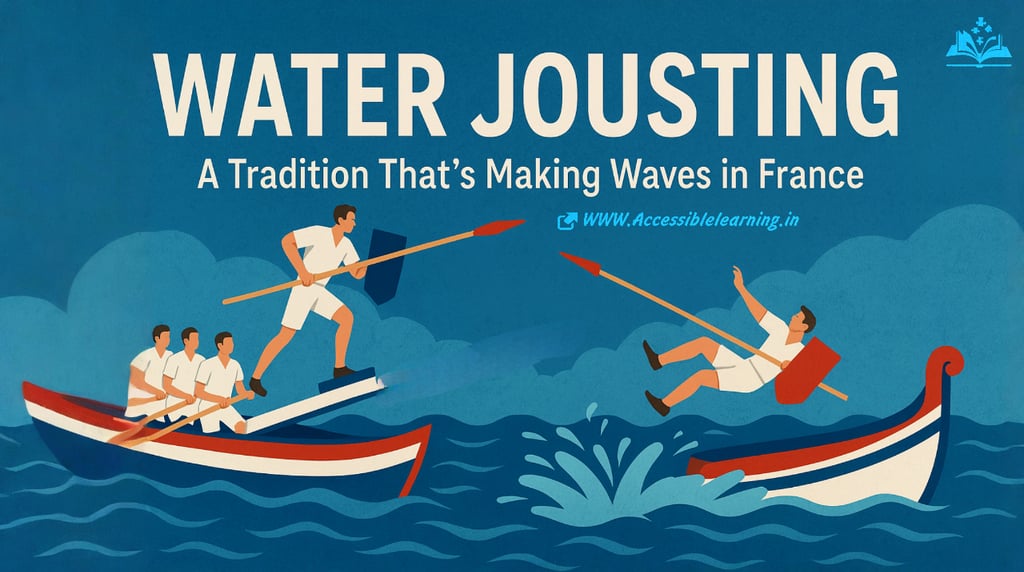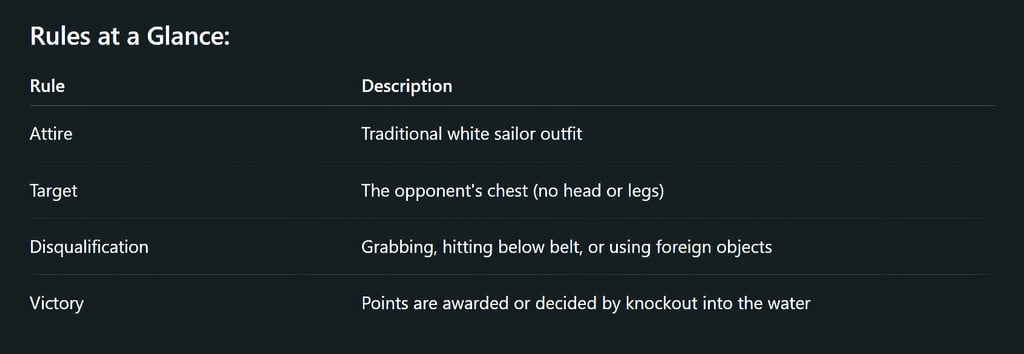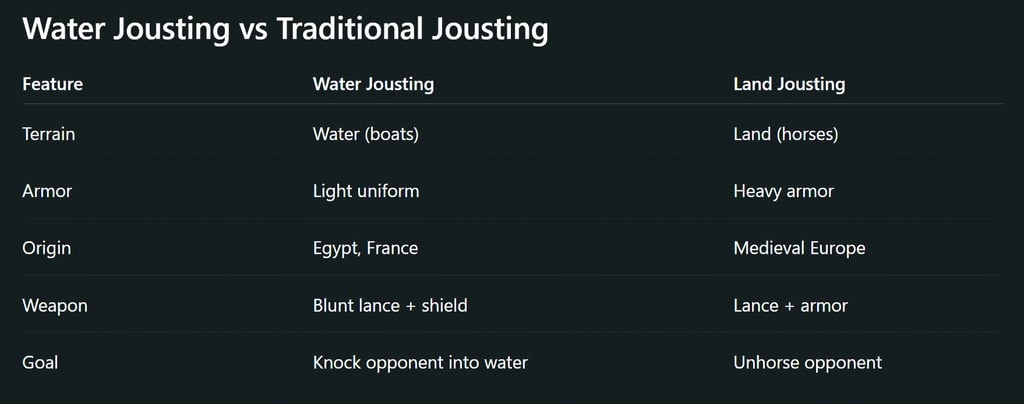
Water Jousting: France’s Riveting Aquatic Duel Tradition
Dive into the splash-filled tradition of Water Jousting, France’s iconic aquatic sport where balance meets bravery. Discover its ancient origins, thrilling tournaments, and cultural significance in coastal communities. From Saint Louis Festival in Sète to jousting tips for beginners, explore how this vibrant tradition blends history, athleticism, and festive flair.
CULTURE/TRADITIONEVENT/SPECIALTRAVEL LIFEEUROPEAN UNION
Kim Shin
8/3/20254 min read


What is Water Jousting?
Water Jousting, also known as Joutes Nautiques, is a traditional aquatic sport where opponents stand on platforms (called tintaine) at the back of boats and attempt to knock each other into the water using wooden lances. This historic game, deeply rooted in French and Mediterranean culture, is a blend of athleticism, balance, and heritage—making it as much a spectacle as a sport.
Originating in ancient Egypt and Greece but formalized in France as early as the 12th century, water jousting is still practiced today, particularly in regions like Sète, Agde, and Givors.
The History of Water Jousting
Ancient Roots: Water jousting dates back to 2780 BCE in Egypt. Greeks and Romans later adopted it for naval training and festive displays.
Medieval France: The first documented French water jousting event occurred in 1177 in Lyon, during a royal visit.
Modern Codification: In 1901, the National Federation of Jousting and Water Rescue (Fédération Française de Joute et de Sauvetage Nautique) was founded, creating formal rules.
How Water Jousting Works: Rules & Gameplay
Key Elements
The Boats: Rowed by a team of 8–10 oarsmen, with a steersman.
The Tintaines: Raised platforms at the stern where jousters stand.
The Weapons: Each jouster wields a blunted wooden lance and a shield.
Objective
Push your opponent off their platform and into the water—without losing your own balance.


Where to Watch Water Jousting in France
Water jousting is a summer spectacle, especially in southern France. Here are the top festivals and locations:
Sète – Saint Louis Festival
When: August
Highlight: The most prestigious jousting event, with parades, music, and thousands of spectators.
Nickname: “Capital of Water Jousting”
Agde Water Jousting Festival
Held along the Hérault River
Family-friendly with junior and senior competitions
Givors Tournament
Near Lyon
Known for honoring historical traditions
Cultural Significance of Water Jousting
Beyond sport, water jousting is a symbol of local identity, especially in the Languedoc and Rhône regions. It’s often part of religious festivals, national holidays, and local celebrations, blending folklore, music, and community pride.
Did You Know?
The jousters often belong to multi-generational guilds, passing down tactics and discipline through the family.
UNESCO recognizes water jousting as an intangible cultural heritage of France.

How to Participate or Train for Water Jousting
Steps to Start
Join a Local Club: Towns like Sète have clubs open to all levels.
Train Your Balance: Core strength and agility are vital.
Learn Boat Dynamics: Understanding movement helps with timing.
Attend Summer Camps: Many regions offer workshops during festivals.
Water Jousting in Popular Culture
Featured in French documentaries and TV series
Used in local tourism promotions for authentic experiences
International tourists now include it in their bucket lists when visiting France
Water Jousting Facts That’ll Surprise You
The Saint Louis Festival in Sète attracts over 100,000 spectators annually.
The lance and shield weigh up to 10 kg—strength and control are key.
There are now water jousting clubs outside of France, in Germany, Switzerland, and Canada.
Interesting Facts About Water Jousting Battles
It’s Over 3,000 Years Old
Water jousting dates back to ancient Egypt, where it was depicted in tomb paintings as early as 2780 BCE. It predates medieval jousting on horseback by millennia.Saint Louis Festival Is the “Wimbledon” of Water Jousting
Held in Sète, France, this annual event attracts over 100,000 spectators, and winning here is considered the highest honor in the sport.Jousters Must Train Like Athletes
Despite appearing festive, jousters undergo rigorous training in balance, strength, timing, and water safety—some train year-round!Falling In Isn’t the End
Being knocked into the water doesn't always mean disqualification. In some formats, players earn points and continue in tournaments after a fall.You Can Start as a Kid
Children as young as 8 years old train and compete in junior leagues, learning the sport from veteran family members and local guilds.The Boats Have No Motors
The jousting boats are powered by rowers (joueurs à la rame), adding a strategic layer where speed and boat balance affect the jouster’s success.The Uniform Is Traditional and Symbolic
Jousters wear white sailor-style outfits, a nod to the sport’s naval heritage, often with sashes that represent their club or town.The Lances Are Blunt but Brutal
Made of solid wood, the lances can weigh up to 8–10 kg and must be controlled precisely to avoid injuries and stay within the rules.Water Jousting Is in the DNA of Sète
Many locals of Sète are born into water jousting families. Some have 3 or more generations of jousters, making it a community identity.It’s Considered for UNESCO Listing
While not officially on the UNESCO Intangible Cultural Heritage list yet, water jousting is recognized regionally as a protected cultural tradition.Jousting Has Its Own Vocabulary
Words like “tintaine” (the platform), “jouteur” (the jouster), and “rameurs” (rowers) are specific to this sport and reflect its deep tradition.It’s Not Just a Sport—It’s a Performance
Jousting matches are often accompanied by live music, parades, and ceremonial processions, blending sport, spectacle, and story.
FAQs About Water Jousting
Q: What is water jousting?
Water jousting is a traditional French sport where competitors stand on boats and try to knock each other into the water using wooden lances.
Q: Where is water jousting practiced?
Primarily in France, especially in Sète, Agde, and Givors. Events are held mostly during summer festivals.
Q: When is the biggest water jousting event?
The Saint Louis Festival in Sète, held every August, is the most famous water jousting tournament.
Q: Is water jousting dangerous?
While it looks intense, water jousting is generally safe due to rules, trained participants, and safety protocols.
Q: Can tourists try water jousting?
Yes! Some local clubs and festivals offer beginner experiences and workshops during the summer months
Water jousting is not just a battle of strength—it's a living heritage, a summer celebration, and a testament to France’s rich cultural tapestry. Whether you're a thrill-seeker, history buff, or curious traveler, witnessing or trying water jousting offers a unique and unforgettable dive into tradition.


Subscribe To Our Newsletter
All © Copyright reserved by Accessible-Learning Hub
| Terms & Conditions
Knowledge is power. Learn with Us. 📚


